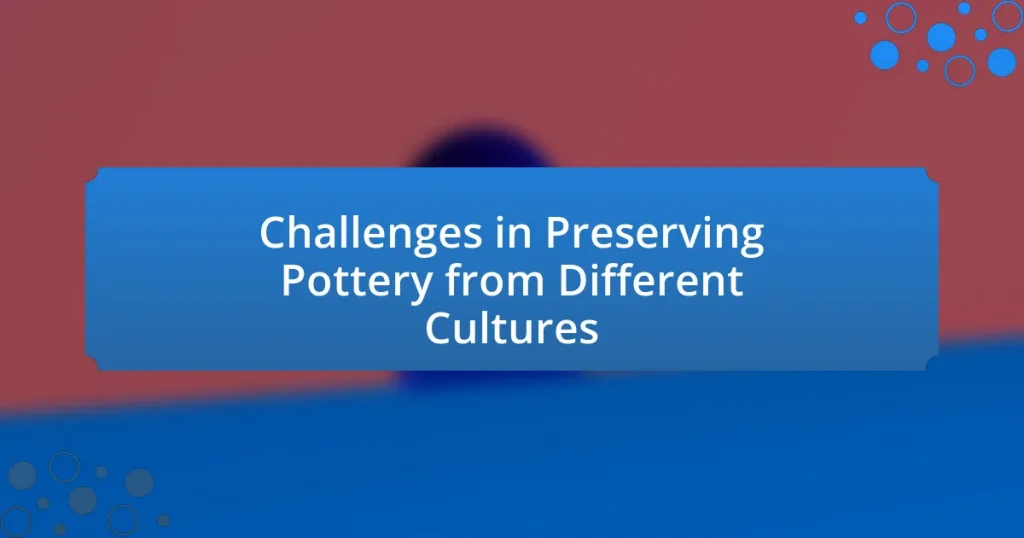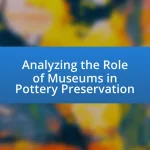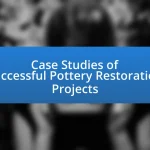The article examines the challenges in preserving pottery from various cultures, highlighting environmental factors, material degradation, and cultural sensitivity as primary concerns. It emphasizes the importance of pottery preservation for cultural heritage, as it provides insights into historical practices and societal identities. The discussion includes the impact of temperature, humidity, and light exposure on pottery integrity, as well as the physical challenges faced during handling and restoration. Additionally, the article explores the role of community involvement, education, and modern technologies in enhancing preservation efforts, while also addressing the differences in preservation practices across cultures.
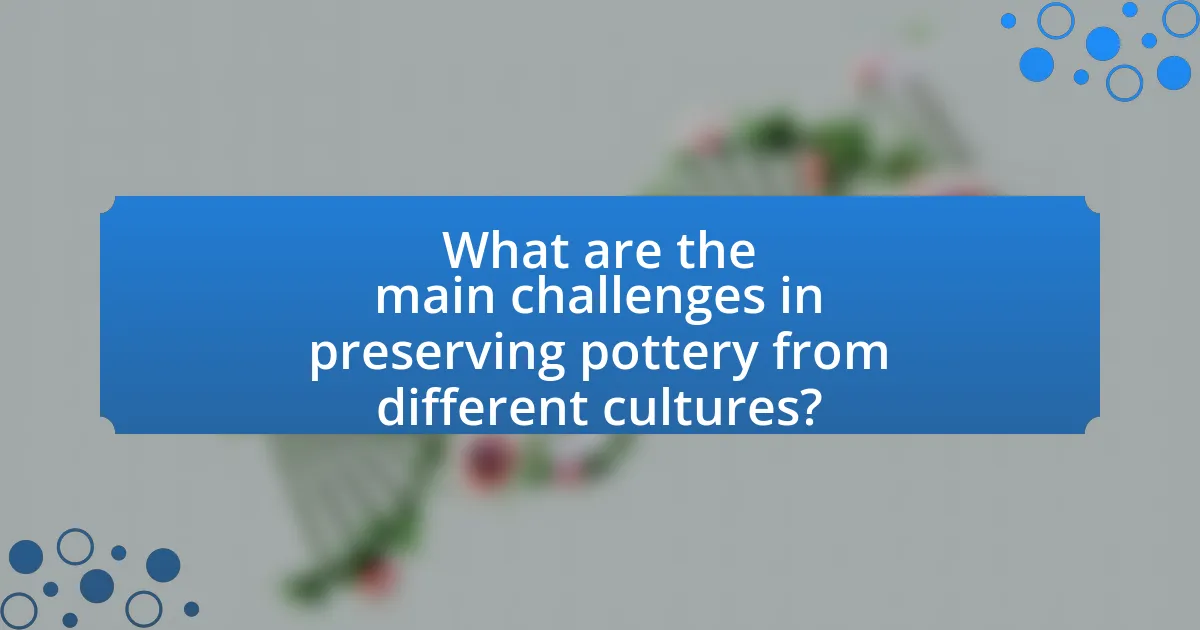
What are the main challenges in preserving pottery from different cultures?
The main challenges in preserving pottery from different cultures include environmental factors, material degradation, and cultural sensitivity. Environmental factors such as humidity, temperature fluctuations, and exposure to light can lead to the deterioration of pottery materials, particularly clay and glazes. Material degradation occurs due to chemical reactions over time, which can weaken the structural integrity of pottery. Additionally, cultural sensitivity poses a challenge, as preservation methods must respect the cultural significance and traditional practices associated with the pottery, which can vary widely among different cultures. For instance, some cultures may prioritize the use of traditional materials and techniques in restoration, while others may favor modern conservation methods.
Why is pottery preservation important for cultural heritage?
Pottery preservation is crucial for cultural heritage because it serves as a tangible link to historical practices, beliefs, and identities of various societies. Preserved pottery provides insights into ancient technologies, trade routes, and social structures, allowing researchers to understand cultural evolution. For instance, the analysis of pottery styles and materials can reveal information about the daily lives of people in ancient civilizations, such as the Minoans or the Incas. Furthermore, pottery often embodies artistic expression and cultural symbolism, making its preservation essential for maintaining the integrity of cultural narratives.
What role does pottery play in understanding historical contexts?
Pottery serves as a crucial artifact for understanding historical contexts by providing insights into the daily lives, cultural practices, and technological advancements of past societies. The analysis of pottery styles, materials, and manufacturing techniques reveals information about trade networks, social structures, and even dietary habits. For instance, the presence of specific clay types and decorative styles can indicate the geographic origins of a community and its interactions with neighboring cultures. Archaeological studies, such as those conducted at sites like Çatalhöyük in Turkey, demonstrate how pottery fragments can date back to 7500 BCE, offering a timeline for human development and cultural evolution. Thus, pottery not only reflects artistic expression but also serves as a tangible link to the socio-economic and cultural dynamics of historical populations.
How does pottery reflect the identity of different cultures?
Pottery reflects the identity of different cultures through its unique styles, techniques, and motifs that embody cultural values and historical narratives. For instance, Native American pottery often features intricate designs that represent spiritual beliefs and community stories, while ancient Greek pottery showcases mythological themes and social practices, illustrating the significance of art in daily life. The distinct materials and firing methods used in various regions also highlight local resources and technological advancements, further emphasizing cultural identity. This connection between pottery and culture is evident in archaeological findings, where specific pottery styles can be traced back to particular civilizations, revealing insights into their social structures, trade practices, and artistic expressions.
What are the common environmental factors affecting pottery preservation?
Common environmental factors affecting pottery preservation include humidity, temperature fluctuations, light exposure, and soil conditions. High humidity can lead to mold growth and deterioration of organic materials, while extreme temperature changes can cause thermal stress, leading to cracks. Prolonged exposure to light, particularly ultraviolet light, can fade pigments and weaken the structure of pottery. Additionally, soil conditions, such as acidity or salinity, can contribute to chemical reactions that damage pottery over time. These factors are critical in determining the longevity and integrity of pottery artifacts.
How do temperature and humidity impact pottery materials?
Temperature and humidity significantly affect pottery materials by influencing their physical properties and structural integrity. High temperatures can lead to thermal expansion, which may cause cracking or warping in pottery, while low temperatures can result in brittleness. Humidity levels impact the moisture content in clay, affecting its workability and drying time; excessive humidity can slow down the drying process, increasing the risk of mold growth and deformation. Research indicates that pottery exposed to fluctuating temperature and humidity conditions is more prone to deterioration, as evidenced by studies on archaeological ceramics that show degradation patterns correlating with environmental changes.
What role does light exposure play in the degradation of pottery?
Light exposure significantly contributes to the degradation of pottery by causing chemical reactions that weaken the material. Ultraviolet (UV) radiation from sunlight can break down the organic compounds in glazes and pigments, leading to fading, discoloration, and loss of structural integrity. Studies have shown that prolonged exposure to light can accelerate the deterioration process, particularly in pottery with organic-based decorations or coatings. For instance, research published in the Journal of Cultural Heritage highlights that UV light can cause irreversible changes in the chemical composition of pottery glazes, resulting in increased fragility and susceptibility to further damage.
What are the physical challenges in preserving pottery artifacts?
The physical challenges in preserving pottery artifacts include fragility, susceptibility to environmental factors, and the risk of deterioration over time. Pottery artifacts are often made from clay, which can be easily broken or chipped, making them vulnerable during handling and storage. Additionally, fluctuations in temperature and humidity can lead to cracking or warping, while exposure to light can cause fading of colors and degradation of materials. Research indicates that improper storage conditions can accelerate the deterioration process, highlighting the need for controlled environments to maintain the integrity of these artifacts.
How does handling and transportation affect pottery integrity?
Handling and transportation significantly affect pottery integrity by increasing the risk of physical damage such as cracks, chips, and breakage. Pottery, being a fragile material, is susceptible to stress and impact during movement. For instance, studies have shown that improper packing and handling can lead to a 30% increase in damage rates during transit. Additionally, vibrations and temperature fluctuations can weaken the structural integrity of pottery, especially if it is made from low-fired clay. Therefore, careful handling and appropriate transportation methods are crucial to preserving the integrity of pottery artifacts.
What are the risks of restoration techniques on original pottery?
Restoration techniques on original pottery pose several risks, including the potential for irreversible damage, loss of authenticity, and alteration of historical context. These techniques, such as the use of adhesives or fillers, can compromise the structural integrity of the pottery, leading to further deterioration. Additionally, the application of modern materials may obscure the original craftsmanship and aesthetic, making it difficult for future scholars to accurately assess the piece’s historical significance. Studies have shown that improper restoration can result in a significant decrease in the value and cultural relevance of the artifact, as evidenced by cases documented in conservation literature.
How do cultural attitudes influence pottery preservation efforts?
Cultural attitudes significantly influence pottery preservation efforts by determining the value placed on traditional craftsmanship and historical artifacts. Societies that prioritize cultural heritage often implement robust preservation initiatives, as seen in countries like Japan, where traditional pottery techniques are celebrated and actively maintained through community workshops and government support. Conversely, cultures that may not emphasize historical artifacts can experience neglect in preservation efforts, leading to the deterioration of pottery that lacks perceived value. For instance, in some urbanized regions, modernity may overshadow traditional practices, resulting in fewer resources allocated for the conservation of local pottery styles. This disparity illustrates how cultural perceptions directly impact the commitment to preserving pottery, shaping both funding and community involvement in preservation activities.
What are the differences in preservation practices across cultures?
Preservation practices across cultures vary significantly due to differing values, resources, and historical contexts. For instance, in Japan, traditional pottery is often preserved through meticulous techniques that emphasize the aesthetic and historical significance of the pieces, such as kintsugi, which repairs broken pottery with gold lacquer, highlighting imperfections. In contrast, Western cultures may prioritize scientific methods, utilizing advanced materials and technologies for conservation, such as chemical treatments and climate-controlled environments to prevent deterioration. Additionally, Indigenous cultures often incorporate spiritual beliefs into preservation, viewing pottery as a living entity that requires respect and care, which influences their methods of storage and display. These differences illustrate how cultural perspectives shape the approach to preserving pottery, reflecting broader societal values and historical experiences.
How do community involvement and education impact preservation success?
Community involvement and education significantly enhance preservation success by fostering local stewardship and increasing awareness of cultural heritage. Engaging communities in preservation efforts leads to a stronger commitment to protecting artifacts, as individuals develop a personal connection to their cultural history. For instance, educational programs that teach the significance of pottery from various cultures can motivate community members to actively participate in preservation initiatives. Research indicates that projects involving local stakeholders often yield higher rates of success, as seen in the case of the “Heritage Lottery Fund” in the UK, which reported that community-led projects resulted in a 70% increase in local engagement and preservation outcomes. This demonstrates that when communities are educated and involved, they are more likely to support and sustain preservation efforts effectively.
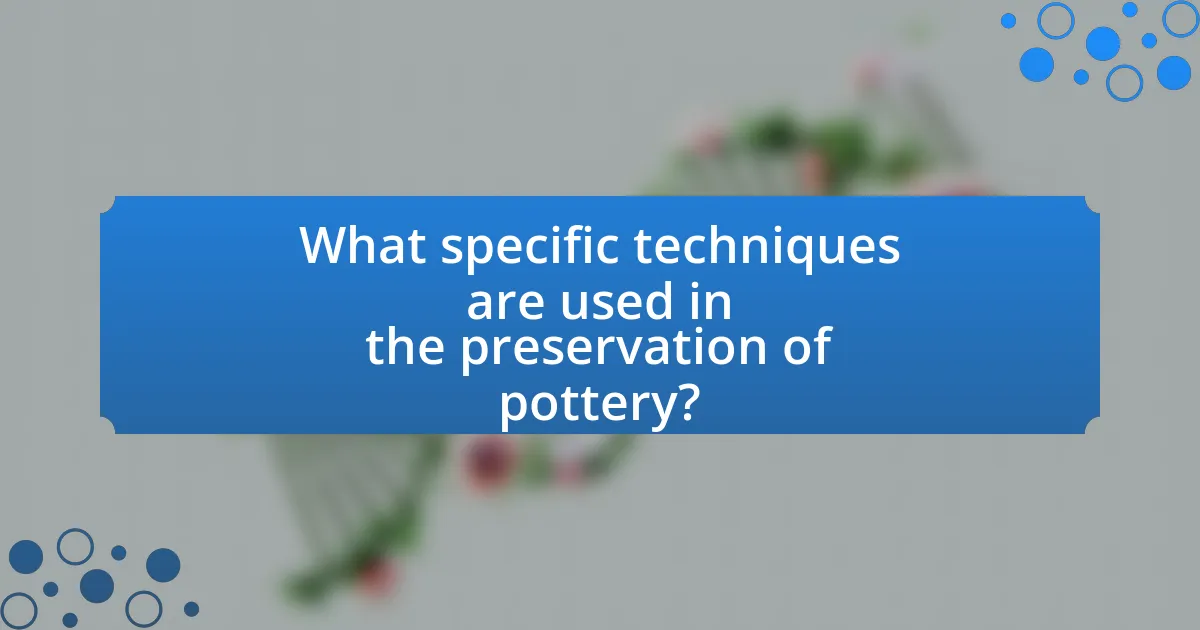
What specific techniques are used in the preservation of pottery?
Specific techniques used in the preservation of pottery include chemical stabilization, physical restoration, and environmental control. Chemical stabilization involves applying consolidants to strengthen fragile pottery, while physical restoration may include reassembling broken pieces using adhesives designed for ceramics. Environmental control focuses on maintaining stable temperature and humidity levels to prevent further deterioration. These methods are supported by practices in conservation science, which emphasize the importance of using compatible materials and techniques to ensure the longevity of pottery artifacts.
What are the most effective conservation methods for pottery?
The most effective conservation methods for pottery include controlled environmental conditions, proper handling techniques, and the use of appropriate materials for restoration. Controlled environments, such as stable temperature and humidity levels, prevent deterioration and damage from fluctuations. Proper handling techniques, including the use of gloves and careful transportation, minimize physical stress on the pottery. Additionally, using conservation-grade adhesives and fillers during restoration ensures compatibility with the original materials, preserving the integrity of the artifact. These methods are supported by best practices outlined by conservation organizations, which emphasize the importance of maintaining the original context and structure of pottery artifacts.
How does cleaning affect the longevity of pottery artifacts?
Cleaning pottery artifacts can significantly enhance their longevity by removing harmful contaminants that can cause deterioration. Regular cleaning helps prevent the buildup of salts, dirt, and biological growth, which can lead to corrosion and structural damage over time. For instance, studies have shown that artifacts exposed to environmental pollutants are more susceptible to degradation, highlighting the importance of proper cleaning techniques. Additionally, using appropriate cleaning methods, such as gentle brushing or chemical treatments specifically designed for ceramics, can preserve the integrity of the pottery while extending its lifespan.
What materials are commonly used in the restoration of pottery?
Common materials used in the restoration of pottery include epoxy resins, adhesives, and fillers. Epoxy resins are favored for their strong bonding properties and durability, making them ideal for reassembling broken pieces. Adhesives, such as cyanoacrylate, are often used for smaller repairs due to their quick-setting nature. Fillers, like plaster or clay, are utilized to reconstruct missing sections and restore the original shape. These materials are selected based on their compatibility with the pottery’s original composition and the desired aesthetic outcome, ensuring that the restoration is both functional and visually cohesive.
How do modern technologies aid in pottery preservation?
Modern technologies aid in pottery preservation through advanced imaging techniques, such as 3D scanning and digital modeling, which allow for detailed documentation and analysis of artifacts without physical contact. These technologies enable conservators to create accurate replicas and assess structural integrity, facilitating restoration efforts. For instance, 3D printing can produce precise replicas of fragile pieces, ensuring that original artifacts remain protected while still allowing for study and display. Additionally, non-invasive chemical analysis techniques, like X-ray fluorescence, help identify materials and degradation processes, guiding conservation strategies. These methods collectively enhance the understanding and preservation of pottery from various cultures, ensuring their longevity for future generations.
What role does digital imaging play in documenting pottery?
Digital imaging plays a crucial role in documenting pottery by providing high-resolution visual records that capture intricate details and surface textures. This technology allows for precise analysis and preservation of pottery artifacts, enabling researchers to study their characteristics without physical handling, which can cause damage. For instance, techniques such as 3D scanning and photogrammetry create accurate digital models that facilitate virtual exhibitions and remote access for scholars. Additionally, digital imaging aids in the identification of stylistic features and manufacturing techniques, contributing to a deeper understanding of cultural contexts and historical significance.
How can 3D printing assist in the restoration of damaged pottery?
3D printing can assist in the restoration of damaged pottery by creating precise replicas of missing or broken pieces, allowing for accurate reconstruction. This technology enables restorers to scan existing pottery fragments and generate 3D models, which can then be printed using materials that closely match the original pottery in appearance and texture. Studies have shown that 3D printing can enhance the fidelity of restorations, as it allows for the integration of intricate designs and patterns that are characteristic of specific cultural artifacts. For instance, a project documented in the journal “Heritage Science” demonstrated the successful use of 3D printing to restore ancient ceramics, highlighting its effectiveness in preserving cultural heritage while maintaining the integrity of the original pieces.
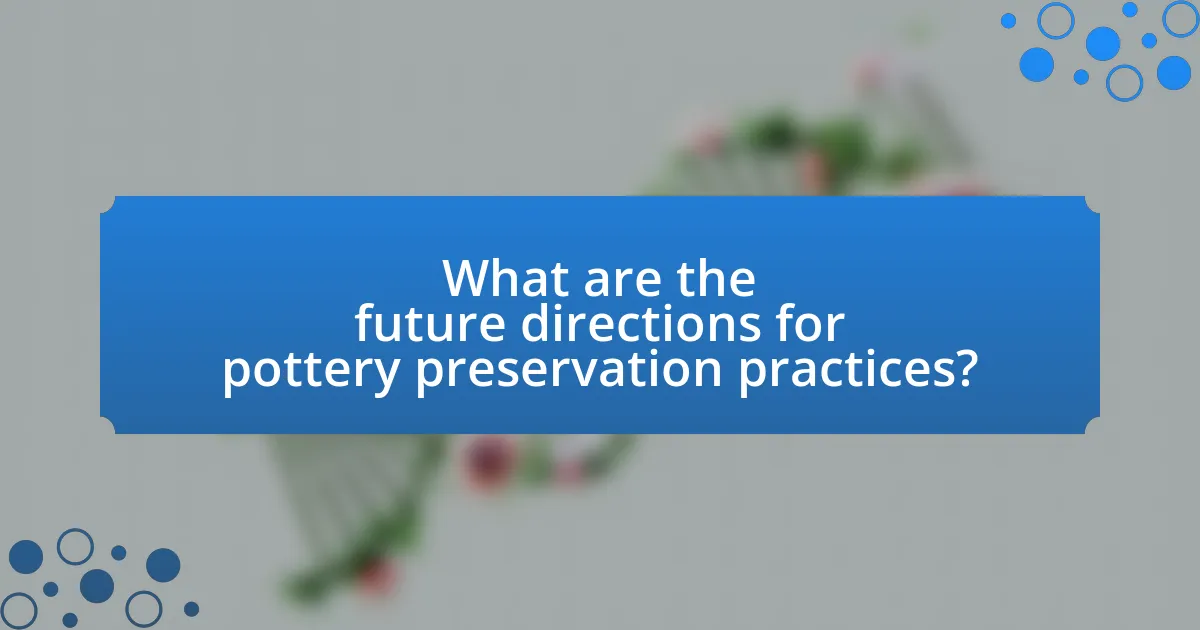
What are the future directions for pottery preservation practices?
Future directions for pottery preservation practices include the integration of advanced technologies such as 3D scanning and digital modeling, which enhance documentation and restoration efforts. These technologies allow for precise replication of pottery artifacts, enabling conservationists to create accurate digital records and physical reproductions without risking damage to original pieces. Additionally, the use of nanomaterials in conservation treatments is gaining traction, as they can provide effective protection against environmental factors while being minimally invasive. Research indicates that these methods not only improve the longevity of pottery but also facilitate better understanding of cultural heritage through enhanced preservation techniques.
How can global collaboration enhance pottery preservation efforts?
Global collaboration can enhance pottery preservation efforts by facilitating the sharing of knowledge, resources, and techniques among diverse cultural institutions and experts. Collaborative initiatives, such as international workshops and joint research projects, allow for the exchange of best practices in conservation methods, which can lead to more effective preservation strategies tailored to specific pottery types. For instance, the International Council of Museums (ICOM) promotes global partnerships that enable museums to share their expertise in pottery conservation, resulting in improved methodologies and increased awareness of the importance of preserving cultural heritage. This collective approach not only strengthens local efforts but also fosters a global appreciation for the significance of pottery across different cultures, ultimately leading to more sustainable preservation practices.
What are the benefits of sharing knowledge and resources internationally?
Sharing knowledge and resources internationally enhances cultural preservation and innovation in pottery conservation. By collaborating across borders, experts can exchange techniques, materials, and research findings that improve methods for preserving pottery artifacts. For instance, international partnerships have led to the development of advanced conservation materials, such as synthetic resins, which are now widely used to restore fragile pottery. Additionally, sharing knowledge fosters a global understanding of cultural heritage, allowing for more effective strategies to protect and celebrate diverse pottery traditions. This collaborative approach not only enriches local practices but also promotes a unified effort in safeguarding global cultural heritage.
How can technology be leveraged for better preservation outcomes?
Technology can be leveraged for better preservation outcomes by utilizing advanced imaging techniques, such as 3D scanning and digital modeling, to create accurate representations of pottery artifacts. These methods allow for detailed documentation and analysis without physical contact, minimizing the risk of damage. For instance, 3D scanning can capture intricate details of pottery surfaces, which can then be used for virtual restoration and study, preserving the original object’s integrity. Additionally, technologies like climate-controlled storage systems and automated monitoring can help maintain optimal environmental conditions, reducing deterioration caused by humidity and temperature fluctuations. These approaches have been validated by studies showing that controlled environments significantly extend the lifespan of artifacts, as evidenced by the successful preservation of ancient pottery in museums worldwide.
What practical steps can individuals take to support pottery preservation?
Individuals can support pottery preservation by participating in local pottery workshops and classes, which promote traditional techniques and raise awareness about the importance of preserving cultural heritage. Engaging in these activities helps to sustain the skills necessary for pottery making, as evidenced by the increasing number of community programs aimed at revitalizing traditional crafts. Additionally, individuals can donate to or volunteer with organizations focused on pottery conservation, such as museums or cultural heritage groups, which often rely on community support to maintain their preservation efforts. This involvement not only aids in the physical preservation of pottery but also fosters a deeper appreciation for the cultural significance of these artifacts.
How can awareness and education promote better preservation practices?
Awareness and education can significantly enhance preservation practices by informing individuals about the cultural, historical, and artistic value of pottery from different cultures. When people understand the importance of preserving these artifacts, they are more likely to engage in responsible practices, such as proper handling, storage, and conservation techniques. For instance, educational programs that highlight the fragility of pottery and the consequences of neglect can lead to increased community involvement in preservation efforts. Research indicates that communities with strong educational initiatives report higher rates of artifact preservation, as seen in the case of the National Park Service’s educational outreach programs, which have successfully increased public participation in preservation activities by over 30% in the past decade.
What are some best practices for caring for personal pottery collections?
To care for personal pottery collections effectively, individuals should implement several best practices. First, pottery should be cleaned gently using a soft, damp cloth to avoid scratches and damage to the glaze. Additionally, pottery should be stored in a stable environment, away from direct sunlight and extreme temperature fluctuations, as these conditions can cause cracking or fading. It is also advisable to use protective padding when displaying pottery to prevent chipping or breaking. Furthermore, regular inspections for signs of wear or damage can help in early detection of issues, allowing for timely repairs. These practices are supported by conservation guidelines from institutions like the American Institute for Conservation, which emphasize the importance of proper handling and environmental control in preserving ceramic artifacts.
